Short-Circuit Current Calculation and Harmonic Characteristic Analysis for a Doubly-Fed Induction Generator Wind Turbine under Converter Control
Abstract
:1. Introduction
2. Transient Mathematical Models of DFIG
2.1. Induction Generator Model
2.2. RSC Control with Consideration of the Limiting Reference Current
2.3. GSC Control Mechanism
3. Converter Transient Response Characteristics of DFIG-WT
3.1. GSC Transient Response Characteristics
3.2. RSC Transient Response Characteristics
4. Transient Short-Circuit Current Calculation Model of DFIG-WT
4.1. DC Bus Voltage
- (1)
- Fundamental frequency attenuation components ∆ir1 and Udc1 account for the highest proportion in rotor current and DC bus voltage, respectively.
- (2)
- DC attenuation components ∆ir2 and Udc2 account for the lowest proportion.
- (3)
- In rotor current, oscillating attenuation components ∆ir3 and ∆ir4, of which both frequencies and time constants are ωci, will cause the homogeneous components Udc3 and Udc4 in DC bus voltage. Due to the high switching frequency of RSC, Udc3 and Udc4 attenuate very quickly. They will attenuate to lower than 10% of their amplitude by about 4 ms.
- (4)
- Udc6 and Udc7 in DC bus voltage are related to the characteristic roots of the transfer function of the DC voltage loop. According to Equation (10), the characteristic roots are related to the intermediate frequency bandwidth of the DC voltage loop. When ωcv < 7, the characteristic roots of the transfer function are a pair of conjugate complexes. Under this circumstance, Udc6 and Udc7 are oscillating attenuation components. The oscillation period is the imaginary part of the characteristic roots, and the attenuation time constant is the reciprocal of the real part of the characteristic roots. When ωcv ≥ 7, the characteristic roots are two different (or same) real numbers. In this case, Udc6 and Udc7 are DC attenuation amplitudes, and the attenuation time constant is the reciprocal of the characteristic roots.
4.2. GSC Current
4.3. Stator Current and DFIG-WT Total Current
4.4. Analysis of Steady-State Current of DFIG-WT Considering Current Limits
5. Simulation Analysis and Verification
5.1. Contrast Verification of Key Electrical Quantities of Generator and Converter
5.1.1. Verification of DC Bus Voltage
5.1.2. Verification of GSC Current
5.1.3. Verification of Rotor Current
5.1.4. Verification of Stator Current
5.2. Contrast Verification of DFIG-WT Transient Characteristics under Different Situations
6. Verification with LVRT Test Data
- (1)
- According to theoretical derivation and Equation (23), the deeper the voltage drops, the higher the second harmonic content will be. It can be seen from Table 4 that when the terminal voltage drops to 0.23 p.u., the second harmonic content in the three-phase short circuit current can reach up to 51.74%, far exceeding the transformer’s second harmonic setting value (15–20%).
- (2)
- Under the same voltage drop level, the second harmonic content is higher under the sub-synchronous condition than the super-synchronous condition. This is because the secondary harmonics are mainly generated by GSC, and the proportion of GSC current to the total current is higher under the sub-synchronous condition, which is consistent with the result in Figure 8.
- (3)
- Then second harmonic content in the three-phase current is different, and this phenomenon can be explained by the mechanism of second harmonic generation. According to the theoretical derivation and the flow chart in Figure 4, the second harmonic component in three phase short circuit currents is originally caused by the DC component in stator flux, which is generated due to the conservation law of flux linkage and its amplitude is determined by the instantaneous value of stator flux at the time the fault occurs. Therefore, the DC attenuation components in the three phases are not equal, so that the second harmonic content in three phases is also different.
- (4)
- The phase with the highest second harmonic content is related to the time of failure due to the same reason at the point (3). In Table 4, the highest second harmonic content is in phase C when the fault occurred at 2.27 s under the super synchronous condition, and it is phase A when the fault occurred at 2.08 s under the sub synchronous condition. As shown in Figure 8, in the simulation study, the fault occurs at the same time in both cases, and the phase with the highest second harmonic content is phase B.
7. Conclusions
- (1)
- Equations for GSC current, DC bus voltage, and rotor current are constructed. The disturbance evolution mechanism in converters and the coupling relationships of the electrical quantities are thus revealed.
- (2)
- The transient analytical models of GSC current, DC bus voltage, stator current, and rotor current are constructed. With the transient analytical model, short-circuit current frequency components, key influencing factors, and attenuation characteristics are quantized.
- (3)
- The amplitude of steady-state short-circuit current of DFIG-WT varies with the post-fault terminal voltage and pre-fault power nonlinearly, considering the multi-limitation of rotor current. Estimation formulas for the maximum steady-state SCC of DFIG-WT and the corresponding voltage are put forward and verified by simulation.
- (4)
- It is proved by theoretical analysis and simulation that the proportion of short-circuit current of GSC is related to the pre-fault operation state. The proportion of GSC current is higher under subsynchronous conditions. The accurate calculation of the total short-circuit current of DFIG-WT should take the influence of GSC current into account, or it will generate up to 30% error.
- (5)
- Reasons for high second harmonic contents contained in the transient short-circuit current of GSC are disclosed. It is concluded that the second harmonic content is positively related to the voltage dip level, and the second harmonic component might have an adverse impact on transformer differential current protection.
Author Contributions
Funding
Acknowledgments
Conflicts of Interest
Nomenclature
| us, ur | Stator and rotor voltage vectors | Ls, Lr | Stator and rotor self-inductances |
| is, ir | Stator and rotor current vectors | Rs, Rr | Stator and rotor resistances |
| ψs, ψr | Stator and rotor flux vectors | Lm | Mutual inductance |
| ig | GSC current vector | C | Capacitance of the capacitor |
| iT | Total current vector of DFIG-WT | L, R | Filter inductance and resistance |
| Udc | DC bus voltage | Pg | Active power of the GSC |
| iL, ig-dc | DC-side currents of RSC and GSC | ira,b,c | AC-side three-phase rotor currents |
| Pload | DC-side active power of the RSC | * | Superscript donating reference value |
| ω1 | Synchronous angular frequency | s | Slip of DFIG |
| Us0, Us1 | Amplitudes of pre-fault and post-fault stator voltages | P*s0, Q*s0 | Reference values of pre-fault stator active and reactive powers |
| p | Differential operator | Sabc | Switch function of the converter |
| d, q | Subscripts donating d-axis component and q-axis component | f, n | Subscripts donating forced component and natural component |
| Note: a symbol in bold form denotes a complex vector. | |||
Appendix A
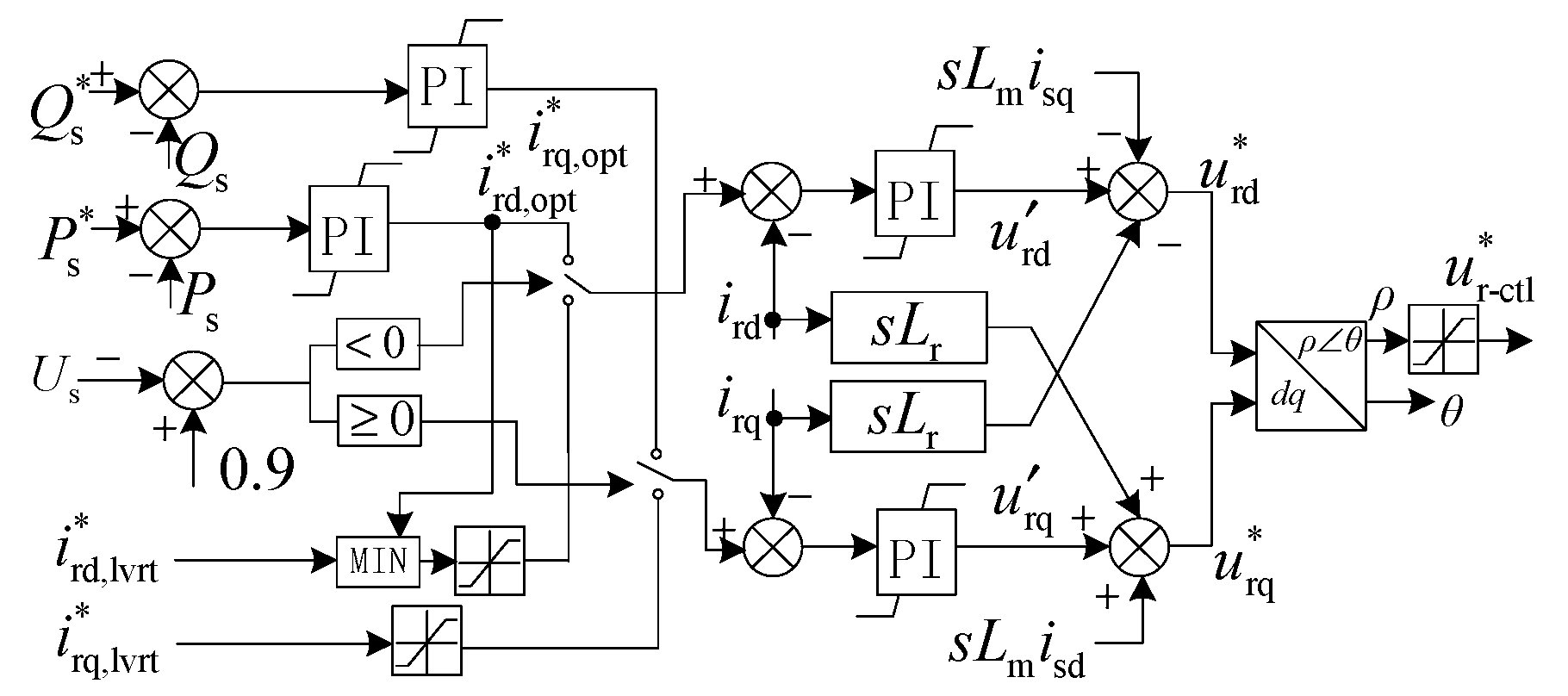
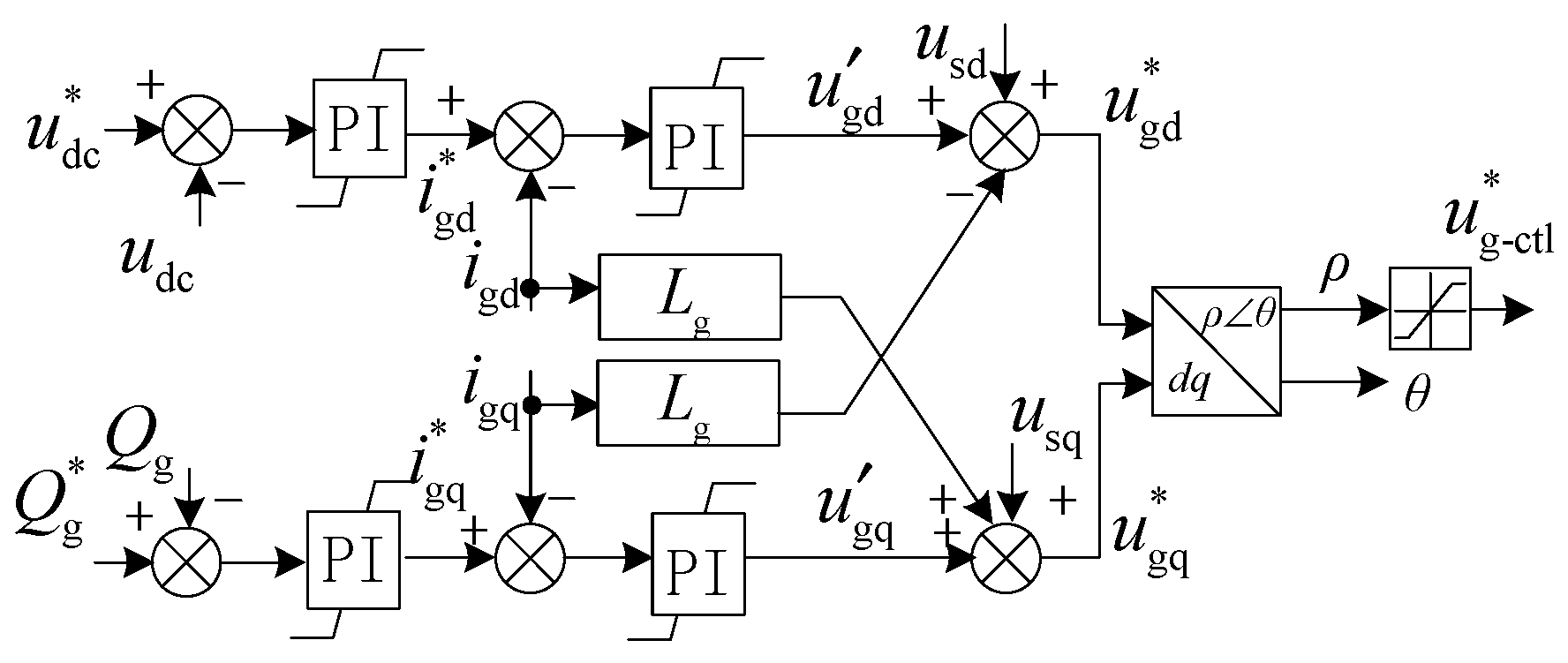
Appendix B
References
- Mai, T.; Wiser, R.; Sandor, D.; Brinkman, G.; Heath, G.; Denholm, P.; Hostick, D.J.; Darghouth, N.; Schlosser, A.; Strzepek, K. Renewable Electricity Futures Study Volume 1: Exploration of High-Penetration Renewable Electricity Futures; National Renewable Energy Laboratory: Golden, CO, USA, 2017. [Google Scholar]
- Li, H.; Eseye, A.T.; Zhang, J.; Zheng, D. Optimal energy management for industrial microgrids with high-penetration renewables. Prot. Control Mod. Power Syst. 2017, 2, 12. [Google Scholar] [CrossRef]
- Tazil, M.; Kumar, V.; Bansal, R.C.; Kong, S.; Dong, Z.Y.; Freitas, W.; Mathur, H.D. Three-phase doubly fed induction generators: An overview. IET Electr. Power Appl. 2010, 4, 75–89. [Google Scholar] [CrossRef]
- Strezoski, V.L.; Prica, D.M. Short-circuit analysis in large-scale distribution systems with high penetration of distributed generators. IEEE/CAA J. Autom. Sin. 2017, 4, 243–251. [Google Scholar] [CrossRef]
- Wang, X.; Pan, X.; Wan, J.; Qi, J.; Zhang, H.; Li, S. A wind farm short-circuit current calculation practical model applied to high voltage power grid simulation. In Proceedings of the 2014 International Conference on Mechatronics, Electronic, Industrial and Control Engineering, Shenyang, China, 17–19 November 2014. [Google Scholar] [CrossRef]
- Shen, S.; Lin, D.; Wang, H.; Hu, P.; Jiang, K.; Lin, D.; He, B. An adaptive protection scheme for distribution systems with DGs based on optimized Thevenin equivalent parameters estimation. IEEE Trans. Power Deliv. 2017, 32, 411–419. [Google Scholar] [CrossRef]
- Kauffmann, T.; Karaagac, U.; Kocar, I.; Jensen, S.; Mahseredjian, J.; Farantatos, E. An accurate type III wind turbine generator short circuit model for protection applications. IEEE Trans. Power Deliv. 2017, 32, 2370–2379. [Google Scholar] [CrossRef]
- Zhou, N.; Wu, J.; Wang, Q. Three-phase short-circuit current calculation of power systems with high penetration of VSC-based renewable energy. Energies 2018, 11, 537. [Google Scholar] [CrossRef]
- Dosoglu, M.K.; Guvenc, U.; Sonmez, Y.; Yilmaz, C. Enhancement of demagnetization control for low-voltage ride-through capability in DFIG-based wind farm. Electr. Eng. 2018, 100, 491–498. [Google Scholar] [CrossRef]
- General Administration of Quality Supervision, Inspection and Quarantine of the People’s Republic of China and the Standardization Administration of the People’s Republic of China. Technical Rule for Connecting Wind Farm to Power System; Xinhua Press: Beijing, China, 2012.
- VDE Verlag GmbH. Technical Requirements for the Connection to and Parallel Operation with Low-Voltage Distribution Networks; VDE Verlag GmbH: Berlin, Germany, 2017. [Google Scholar]
- Swain, S.; Ray, K.P. Short circuit fault analysis in a grid connected DFIG based wind energy system with active crowbar protection circuit for ride-through capability and power quality improvement. Electr. Power Energy Syst. 2017, 84, 64–75. [Google Scholar] [CrossRef]
- Zhu, Q.; Ding, M.; Han, P. Equivalent modeling of DFIG-based wind power plant considering crowbar protection. Math. Probl. Eng. 2016, 2016, 8426492. [Google Scholar] [CrossRef]
- Yuan, Y.H.; Wu, F. Short-circuit current analysis for DFIG wind farm considering the action of a crowbar. Energies 2018, 11, 425. [Google Scholar] [CrossRef]
- Yin, J.; Bi, T.; Xue, A.; Yang, Q. Study on short circuit current and fault analysis method of double fed induction generator with low voltage ride-through control strategy. Trans. China Electr. Tech. Soc. 2015, 30, 118–125. [Google Scholar]
- Ouyang, J.; Zheng, D.; Xiong, X.; Xiao, C.; Yu, R. Short-circuit current of doubly fed induction generator under partial and asymmetrical voltage drop. Renew. Energy 2016, 88, 1–11. [Google Scholar] [CrossRef]
- Kong, X.; Zhang, Z.; Yin, X.; Wen, M. Study of fault current characteristics of the DFIG considering dynamic response of the RSC. IEEE Trans. Energy Convers. 2014, 29, 278–287. [Google Scholar]
- Abad, G.; Lopez, J.; Rodrlguez, A.M.; Marroyo, L.; Iwanski, G. Doubly Fed Induction Machine: Modeling And Control For Wind Energy Generation; Wiley-IEEE Press: Hoboken, NJ, USA, 2014; pp. 246–247. [Google Scholar]
- Xiao, S.; Geng, H.; Zhou, H.; Yang, G. Analysis of the control limit for rotor-side converter of doubly fed induction generator-based wind energy conversion system under various voltage dips. IET Renew. Power Gener. 2013, 7, 71–81. [Google Scholar] [CrossRef]
- Hu, J.; He, Y. DFIG wind generation systems operating with limited converter rating considered under unbalanced network conditions—Analysis and control design. Renew. Energy 2011, 36, 829–847. [Google Scholar] [CrossRef]
- Chen, P.; Zhang, Z.; Yin, X.; Xiao, F.; Yang, Z.; Wang, L. Steady fault current calculation model of doubly-fed induction generator considering grid-side converter current and different control strategies. Autom. Electr. Power Syst. 2016, 40, 8–16. [Google Scholar]
- Honrubia-Escribano, A.; Jiménez-Buendía, F.; Gómez-Lázaro, E.; Fortmann, J. Field validation of a standard type 3 wind turbine model for power system stability, according to the requirements imposed by IEC 61400-27-1. IEEE Trans. Energy Convers. 2018, 33, 137–145. [Google Scholar] [CrossRef]
- Zhang, C.W.; Zhang, X. PWM Rectifier and Control; Machine Press: Beijing, China, 2003; pp. 114–117. [Google Scholar]
- Xiao, F.; Zhang, Z.; Yin, X. Fault current characteristics of the DFIG under asymmetrical fault conditions. Energies 2015, 8, 10971–10992. [Google Scholar] [CrossRef]
- Liu, S.M.; Bi, T.S.; Jia, K.; Yang, Q.X. Coordinated fault-ride-through strategy for doubly-fed induction generators with enhanced reactive and active power support. IET Renew. Power Gener. 2016, 10, 203–211. [Google Scholar] [CrossRef]
- Lopez, J.; Sanchis, P.; Roboam, X.; Marroyo, L. Dynamic behavior of the doubly fed induction generator during three-phase voltage dips. IEEE Trans. Energy Convers. 2007, 22, 709–717. [Google Scholar] [CrossRef]
- National Energy Administration. Test Procedures of WIND Turbine Low Voltage Ride Through Ability; Xinhua Press: Beijing, China, 2015. [Google Scholar]


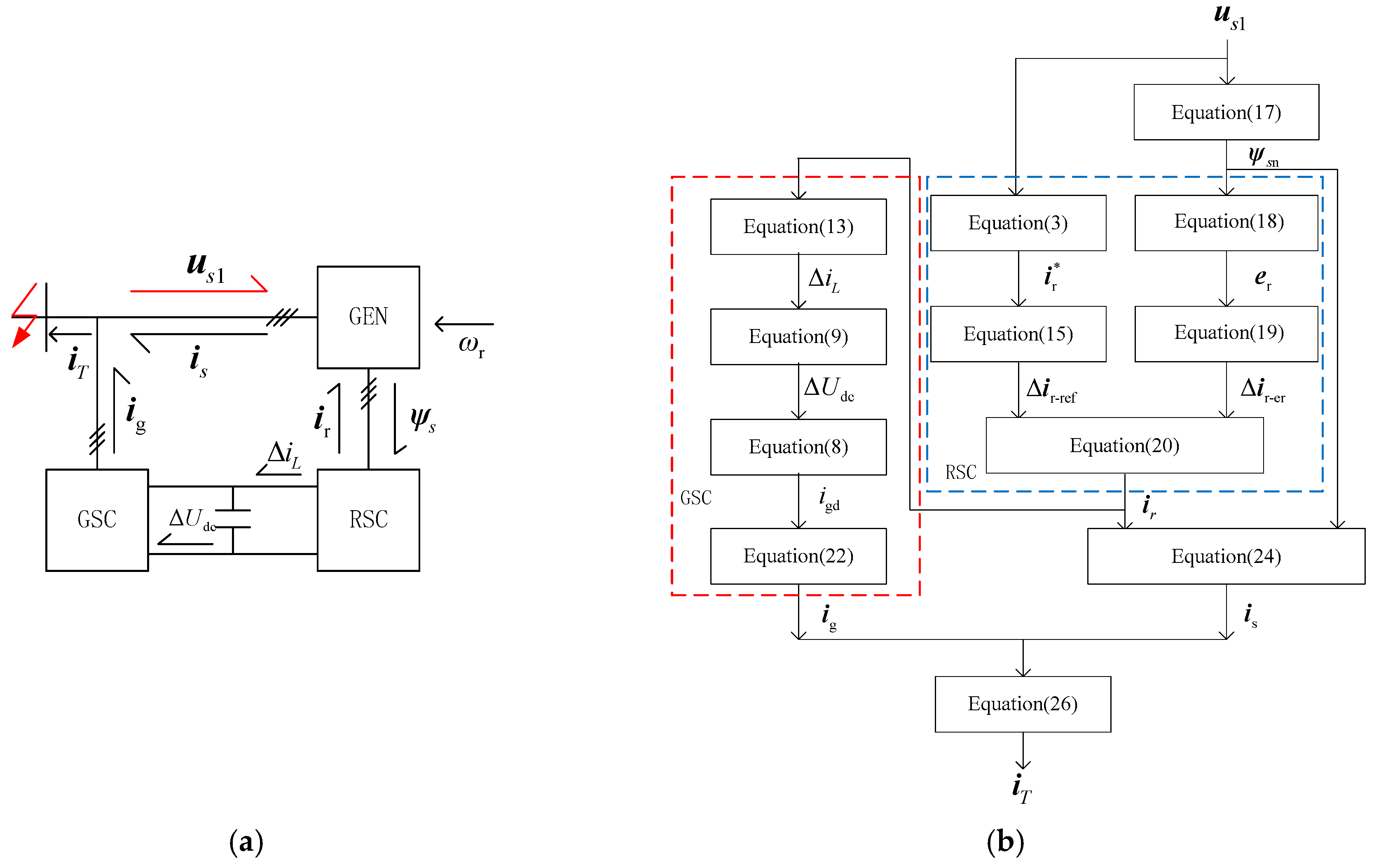
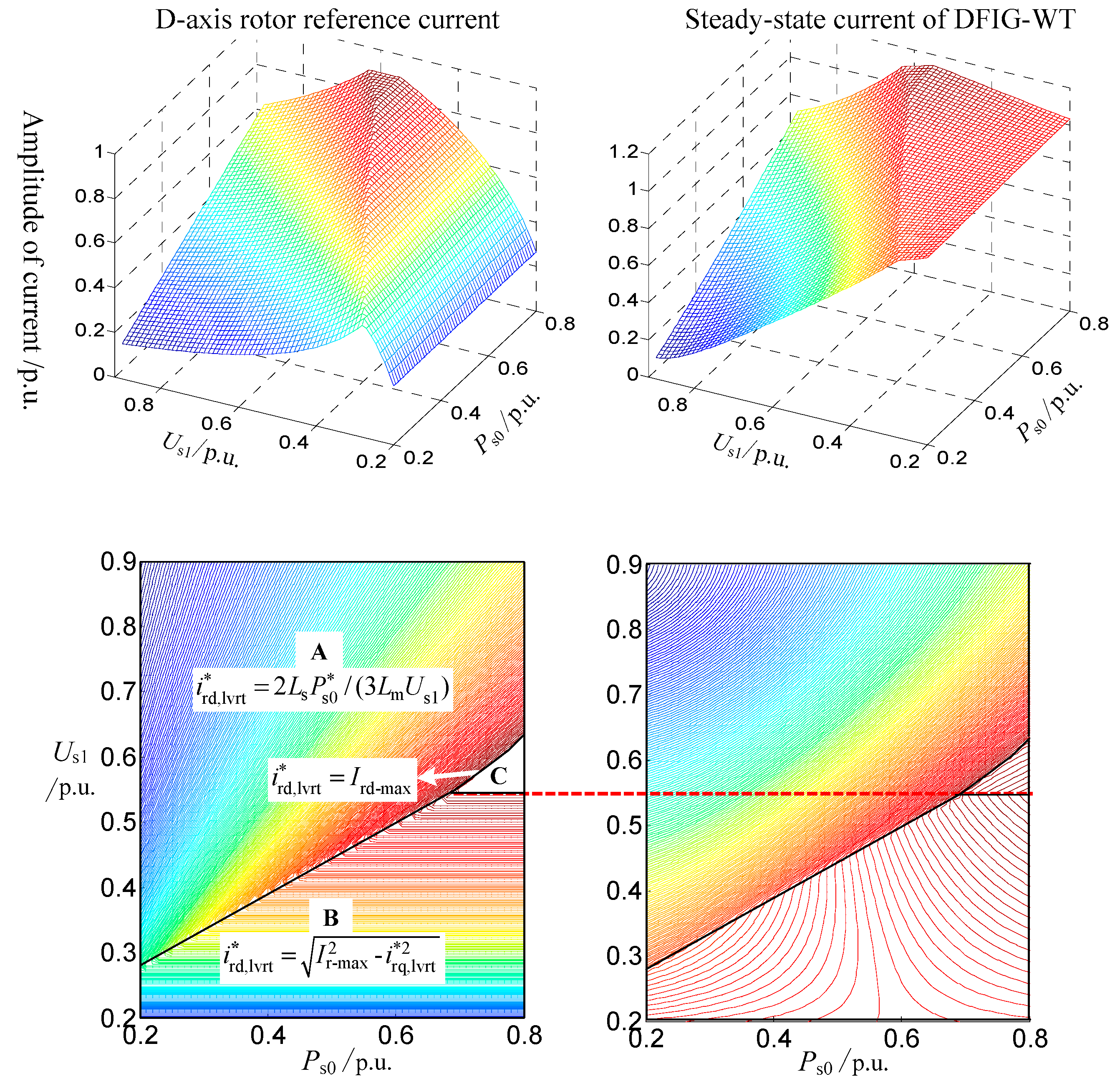








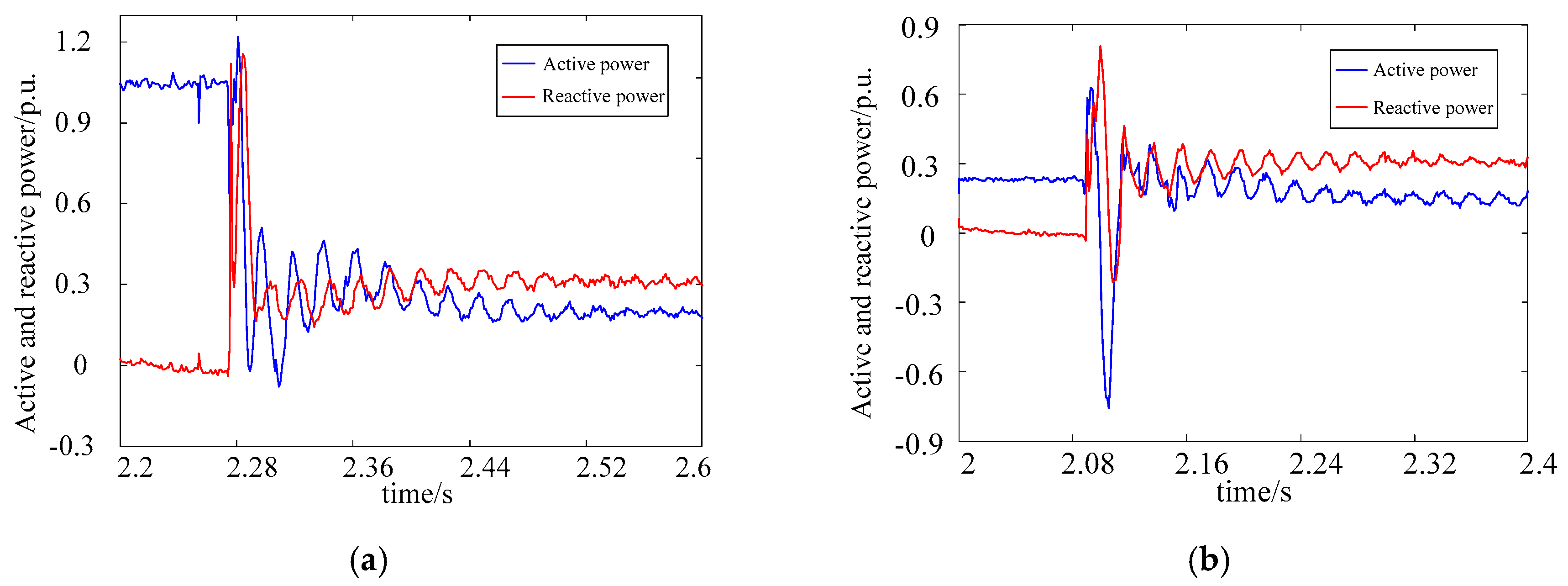

| ir Coefficient Amplitude/p.u. | ∆Udc Coefficient Amplitude/p.u. | Attenuation Time Constant | |||
|---|---|---|---|---|---|
| ∆ir1 | 0.7026 | Udc1 | 0.1351 | τs | 0.0306 |
| ∆ir2 | 0.0316 | Udc2 | 0.0009 | τi | 0.0575 |
| ∆ir3 | 0.2112 | Udc3 | 0.0312 | 1/ωci | 0.0019 |
| ∆ir4 | 0.2275 | Udc4 | 0.0410 | 1/ωci | 0.0019 |
| ∆ir* | 0.3332 | Udc5 | 0.0369 | 1/ωci | 0.0019 |
| Udc6 | 0.0505 | −1/λ1 | 0.0079 | ||
| Udc7 | 0.0579 | −1/λ2 | 0.004 | ||
| Parameter | Value | Parameter | Value |
|---|---|---|---|
| Rated capacity | 1.5 MW | Switching frequency of RSC | 1.6 kHz |
| Rated voltage of stator | 690 V | Proportionality coefficient of inner current loop | 0.578 |
| Stator resistance | 0.023 p.u. | Integral coefficient of inner current loop | 10.58 |
| Rotor resistance | 0.016 p.u. | Switching frequency of GSC | 2.7 kHz |
| Stator inductance | 3.08 p.u. | Proportionality coefficient of DC voltage loop | 6.17 |
| Rotor inductance | 3.06 p.u. | Integral coefficient of DC voltage loop | 400 |
| Rated DC bus voltage | 1150 V | Reactive current coefficient Kd | 1.5 |
| Active current-limiting of rotor | 0.9 p.u. | Maximum current-limiting value of rotor | 1.15 p.u. |
| DC bus capacitor | 0.0032 p.u. | Modulation coefficient of PWM | 0.95 |
| Parameter | Value | Parameter | Value |
|---|---|---|---|
| Rated capacity | 1.5 MW | Leakage inductance of rotor | 0.0162 Ω |
| Rated voltage of stator | 690 V | Exciting inductance | 1.123 Ω |
| Rated voltage of rotor | 1800 V | Switching frequency of converter | 2.5 kHz |
| Stator resistance | 0.0023 Ω | Current-limiting value of rotor | 1.5 p.u. |
| Rotor resistance | 0.0024 Ω | Reactive current coefficient | 1.8 |
| Leakage inductance of stator | 0.0184 Ω | Rated voltage of DC bus | 1150 V |
| Proportionality coefficient of inner current loop | 0.6 | Proportionality coefficient of DC voltage loop | 10 |
| Integral coefficient of inner current loop | 15 | Integral coefficient of DC voltage loop | 500 |
| DC bus capacitor | 0.001 F | Modulation coefficient of PWM | 0.95 |
| Operating Condition | A-Phase | B-Phase | C-Phase |
|---|---|---|---|
| Super-synchronous | 32.68% | 25.16% | 43.40% |
| Subs-synchronous | 49.45% | 34.58% | 51.74% |
© 2018 by the authors. Licensee MDPI, Basel, Switzerland. This article is an open access article distributed under the terms and conditions of the Creative Commons Attribution (CC BY) license (http://creativecommons.org/licenses/by/4.0/).
Share and Cite
Li, J.; Zheng, T.; Wang, Z. Short-Circuit Current Calculation and Harmonic Characteristic Analysis for a Doubly-Fed Induction Generator Wind Turbine under Converter Control. Energies 2018, 11, 2471. https://doi.org/10.3390/en11092471
Li J, Zheng T, Wang Z. Short-Circuit Current Calculation and Harmonic Characteristic Analysis for a Doubly-Fed Induction Generator Wind Turbine under Converter Control. Energies. 2018; 11(9):2471. https://doi.org/10.3390/en11092471
Chicago/Turabian StyleLi, Jing, Tao Zheng, and Zengping Wang. 2018. "Short-Circuit Current Calculation and Harmonic Characteristic Analysis for a Doubly-Fed Induction Generator Wind Turbine under Converter Control" Energies 11, no. 9: 2471. https://doi.org/10.3390/en11092471





